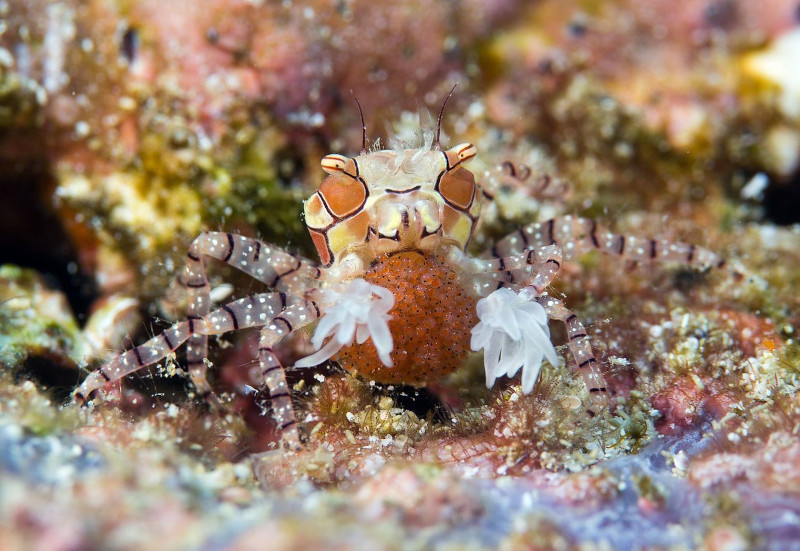
Pom-pom Crab Facts
- Drawing great attention, this intriguing product of Nature and evolution usually goes by the colorful common name of the Pom-pom Crab. It does have at least one other accepted general title, though. That’s the descriptive, yet unusual, name of Boxer Crab.
- Inside of the scientific community, however, it’s frequently referred to by its technical name. But that, like so often holds true, is a somewhat difficult one for the layperson to pronounce. That’s because it holds the official moniker of Lybia edmondsoni.
- It received that tongue-twisting appellation due to the efforts of the team of Takeda & Miyake. The Japanese researchers accomplished the first recognition of it as a separate and distinct species. They managed that scientifically noteworthy deed in 1970.
- Regardless of which of these names one chooses to use, it remains a fascinating species. It’s especially noted for one of its behavioral characteristics. It often carries a sea anemone around in each of its claws. This serves as the source of the strange name.
- To the current knowledge of scientists, the remarkable Pom-pom Crab inhabits a moderate range. Precise data regarding its population also remains unavailable. Due to that lack of information, and despite its limited presence, the IUCN has no listing for it.
- It nevertheless likely should be considered as facing multiple potential threats to its continued existence, at least. Most of these also probably stem from human activites. The most probably of these include habitat loss, and, of course, climate change.
Related Articles
Pom-pom Crab Physical Description
The gorgeous and intriguing Pom-pom Crab fully merits the appreciation it receives from those who view it. The Arthropod does not do so, however, due to any imposing size. That’s true since this wonder of evolution represents a very tiny member of its Order.
In terms of those physical measurements, the creature also follows a pattern extremely common among its many relatives. That’s in the fact that this invertebrate manifests no particularly noticeable degree of the physiological characteristic named sexual dimorphism.
Males and females thus attain virtually the same traits. This makes identifying the genders of individuals difficult for untrained observers. Both sexes reach an average body width of 0.5 in (1.3 cm). Each also attains a mean length of approximately 2 in (5 cm).
The lovely Pom-pom Crab further displays other appealing attributes, that fully make up for any perceived deficiency in size. Interestingly, the majority of the carapace presents a very unusual pattern of polygonal patterns. These show combinations of pink, brown, and yellow.
Contrasting this tendency, however, is the appearance of the legs of the animal. These appendages generally develop as a dark shade of purple. Many specimens further present darker bands on the same legs. The legs and body also have backward-pointing spines.
- Kingdom: Animalia
- Phylum: Arthropoda
- Class: Malacostraca
- Order: Decapoda
- Family: Xanthidae
- Genus: Lybia
- Species: L. edmondsoni
Pom-pom Crab Distribution, Habitat, and Ecology
As nonted previously, the Pom-pom Crab appears to have evolved as native to a moderate-sized swathe of the globe. That precise zone of habitation likely won’t surprise many readers, however. It seems to be endemic to tropical portions of the Indo-Pacific Ocean.
Yet, inside of that greater region, it makes its home in a very specific section. This extends roughly from the Red Sea and the coast of East Africa in one part. From there, that territory extends to New Guinea and Indonesia. It’s unknown if it appears elsewhere, or if it ever did.
The remarkable Decapod further displays decidedly strong preferences regarding its choice of habitat. In this, it once again mimics behavioral patterns common to its kind. The creature makes its home almost exclusively in areas comprised of sandy or gravelly seabeds.
Its environmental needs include even more precision, however. It also requires the presence of corals. It lives among them, and typically clings tenaciously. All of these must additionally lay in shalalow areas. The invertebrate only resides at depths of 66 ft (20 m) or less.
Like the majority of its relations, the Pom-pom Crab evolved as omnivorous in nature. The animal also feeds opportunistically, consuming virtually anything it finds. It eats with its small maxillipeds, since holding the sea anemones in its claws precludes using them.
Carrying these invertebrates in this manner represents an impressive learned behavior. With them it threatens any potential predator with their stinging tentacles. Meanwhile, the amazing crab itself remains unthreatened, due to the nature of its protective carapace.
Species Sharing Its Range
Check out our other articles on 4 Gorgeous European Gorges, Striped Skunk, Victoria Falls, Wilson’s Bird-of-paradise, Rosy Veincap, Axolotl, Australian Painted Lady, Alligator Snapping Turtle
